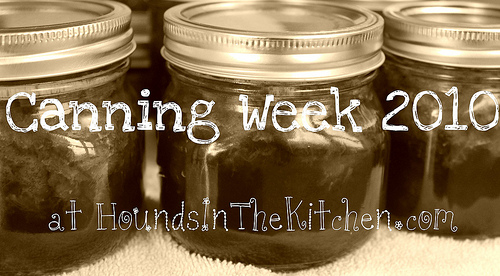It's canning week! I have five days of recipes, tips, and theory ready to share. Whether you are a beginning canner or looking to advance your skills, stay tuned this week. First up, pectin!
 As a self-proclaimed homesteader, I am asked all sorts of questions that I would never think of myself. My friend Susan queried me about pectin the other day. I had some information to share but realized that I knew precious little about this jam staple.
As a self-proclaimed homesteader, I am asked all sorts of questions that I would never think of myself. My friend Susan queried me about pectin the other day. I had some information to share but realized that I knew precious little about this jam staple.
What is pectin?
My cookbooks and the trusty Internet inform me that pectin is a naturally occurring heteropolysaccharide found in the cell walls of plants. Apples and citrus peels contain high amounts of pectin; other fruits contain less.
Commercial pectin is made by extracting pectin from apples or citrus peels (by-products of juice production) with a hot dilute acid. The resulting extract is precipitated, washed and dried.
Pectin was first described by Henri Braconnot in 1825. Before his discovery, jams and jellies were set by including some apple peel or citrus peel in the jam or boiling the fruit and sugar mixture for extended periods of time.
Why pectin is used in jam making
Pectin sets or gels a fruit and/or juice mixture, giving it a spreadable texture. The gel forms as molecular chains of pectin change shape and trap water when in contact with fruit acids. This process does not aid in the preservation of jam or jelly; room temperature shelf stability is achieved by acid content and pressure and temperature changes.
I prefer a fruit-forward jam with minimal sugar. Using pectin allows me to achieve a spreadable texture within these constraints. Pectin also allows a short cooking time (1 minute at a full boil) which may preserve some nutritive value over no-pectin recipes which call for upwards of 30 minutes of boiling.
Some continue to favor no-pectin recipes. Jams and jellies made without pectin can still have a jelled consistency if a) the recipe contains the right amount of pectin-containing fruits or b) large amounts of sugar are used and the mixture is allowed to boil until thick. Also, some do not mind if the jam turns out a bit runny.
Types of pectin
Ball, Sure-Jel, and Octo all make dry high-ester pectin for full or low sugar. Packets can be found in grocery stores, hardware stores (in season), and online. Most have an expiration date beyond which the pectin will less reliably set.
Pomona's Universal Pectin, my favorite brand, is a low-ester pectin that requires the use of calcium water to form the gel. This brand is found online or at natural food stores. Locally I pick it up at the Clintonville Community Market.
Making your own pectin is another alternative. You simply boil under ripe apples or crab apples with lemon juice and water, strain the mixture, and seal it in jars. Mother Earth News has a complete recipe.
Tomorrow I'll share why I love Pomona's with a peach jam recipe.
What else do you want to know about pectin?
This post was entered in the Fight Back Friday August 6, 2010. Click through to read more local sustainable food acts.
